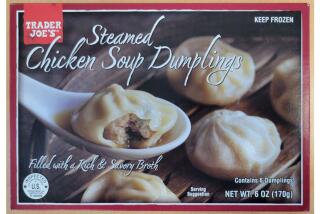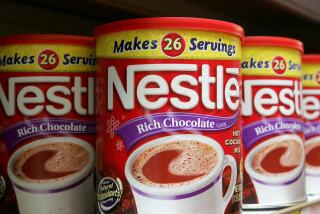McDonald’s recall of ‘Shrek’ glasses raises disturbing questions
It’s bad enough that about 12 million potentially toxic “Shrek” drinking glasses were recalled by McDonald’s last week.
But what should really get people’s alarm bells ringing is the fact that nobody seems to know, or is willing to say publicly, how the carcinogenic metal cadmium got into paint used to depict Shrek, Donkey and other characters.
Worse, federal law allows cadmium to be in a product marketed to children as long as the product isn’t a toy, raising questions as to how many other goods may be out there that also pose a health risk.
“We’re still trying to figure out whether this is just the tip of the iceberg,” said Rachel Weintraub, director of product safety for the Consumer Federation of America. “All we know is that the company that made the glasses for McDonald’s makes a lot of products for a lot of clients.”
Cadmium has been linked to a variety of serious ailments, including kidney and liver damage. The U.S. Centers for Disease Control and Prevention rank it as the seventh most hazardous substance in the environment.
But the Consumer Product Safety Commission, which orchestrated the McDonald’s recall, bans use of cadmium only on the surface of kids’ toys. Other uses are not explicitly prohibited.
Cadmium is typically added to paint to create bright reds and yellows. Some manufacturers have used it as a substitute for lead. Earlier this year, federal authorities said they were particularly alarmed by cadmium-tainted kids’ jewelry made in China.
“There’s definitely a lack of rules when it comes to cadmium,” said Robert Hopkins, a partner at the law firm Duane Morris who specializes in product-safety issues. “The regulations for cadmium now only focus on toys.”
And is a “Shrek” drinking glass a toy?
“It’s not a toy,” said Alex Filip, a spokesman for the Consumer Product Safety Commission. “McDonald’s didn’t have to recall the glasses.”
For that reason, he praised the restaurant chain for being “a good corporate citizen that puts its customers first.”
McDonald’s started offering $3 refunds Wednesday, even though the glasses cost $1.99 with a food purchase and $2.49 without. The company said it wanted to ensure that people were compensated for any taxes paid or for the inconvenience of returning tainted glasses.
Still, questions abound.
First and foremost, how did cadmium get into the paint in the first place? The glasses were apparently manufactured in Millville, N.J., by ARC International North America. Did the paint come from there or from somewhere else?
“The real story here is the supply chain,” said Weintraub at the Consumer Federation of America. “If the paint came from elsewhere, there’s no telling how many other manufacturers may have used it.”
Filip at the product-safety agency said government officials haven’t delved into the source of the paint. “Our primary concern was getting the glasses out of the chain of commerce,” he said.
Obviously ARC International North America knows exactly where it got the paint. But no one at the company returned my repeated calls for comment.
The company is a subsidiary of France’s Arc International, which describes itself as a world leader in glassware and tableware. Its brands include Pyrex, Luminarc and Arcoroc.
Fred Dohn, Arc International’s chief exec for North America, said in a statement that all of the company’s products “meet the highest standards of quality and safety.” He said Arc viewed the recall “as an internal decision by McDonald’s.”
Lisa Howard, a McDonald’s spokeswoman, said by e-mail that the paint came from France. But she declined to say whether it was produced by ARC or by a subcontractor, or whether the ingredients for the paint also originated in France.
Nor did Howard address whether the cadmium was incorporated into the paint deliberately or accidentally. Europe has banned cadmium from most electrical and electronic goods, and there’s been talk of a blanket ban on cadmium in all products.
Cadmium is included in the European Union’s Restriction of Hazardous Substances directive, which aims to limit the public’s exposure to toxic materials.
For that reason, it’s hard to imagine a French company deliberately including cadmium in paint, or that a European manufacturer would use paint known to contain cadmium.
So again you have to ask: How did the stuff get in there?
Moreover, did McDonald’s test for the presence of cadmium before the glasses went on sale? And if it did, why didn’t the company act sooner?
The company says the recalled glasses were “evaluated by an independent third-party laboratory, accredited by the CPSC, and determined to be in compliance with all applicable federal and state requirements at the time of manufacture and distribution.”
Filip at the Consumer Product Safety Commission said this wasn’t surprising. “Everything would have met the law because we haven’t set limits for this,” he said.
Yet McDonald’s says it agreed to recall the glasses “in an abundance of caution” after being notified by the safety agency that Rep. Jackie Speier (D-Hillsborough) had received an anonymous tip about cadmium in the paint.
It’s unclear whether McDonald’s tested the glasses before they went on sale or only after Speier voiced concern about cadmium in the paint. Howard, the company spokeswoman, couldn’t be reached for comment on the matter.
“It’s very unnerving that it took a tip to a member of Congress to get something moving,” Speier told me.
Speier said it seems unlikely the paint originated in Europe, where safety regulations for hazardous materials are much stricter than in the United States. She suspects it came from China, one of the world’s leading producers of cadmium.
Speier wants to expand current regulations to include a ban on cadmium in all products marketed to or intended for kids.
That’s a good start. I’d go a step further and require companies to clearly identify the country of origin for all components and ingredients.
It’s not about imposing more onerous rules on businesses. It’s about accountability for products sold, especially when kids are involved.
The Consumer Product Safety Commission says it will have new cadmium rules available for public comment this summer.
David Lazarus’ column runs Tuesdays and Fridays. He also can be seen daily on KTLA-TV Channel 5. Send your tips or feedback to david.lazarus@latimes.com.
More to Read
Inside the business of entertainment
The Wide Shot brings you news, analysis and insights on everything from streaming wars to production — and what it all means for the future.
You may occasionally receive promotional content from the Los Angeles Times.











